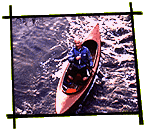
Will you take a walk down the LA River with me? It's not far and you will see how the water from the mountains runs down through our city.

Kayaking L.A.
Finding a small piece of solitude in a city of three million inhabitants is no easy task, but for Los Angeles resident Denis Schure, it's simply a matter of hoisting a canoe over his head, crossing the street, and dropping into the nearby Los Angeles River.
"Literally, in the heart of the city you can get on stretches of the river that are essentially unknown and invisible," says Schure. "We're talking green, attractive... teeming with wildlife. It's quite amazing and reassuring."
 If, as Thoreau observed in Walden, "the life in us is like the water in the river," one hopes this doesn't apply to the Los Angeles River. An international symbol of a city that grew up too fast, the river has become a post-apocalyptic backdrop for graffiti artists and Hollywood chase scenes, all the while serving as a primary drainage channel for every toilet, factory, and storm drain east of the 405 Freeway.
If, as Thoreau observed in Walden, "the life in us is like the water in the river," one hopes this doesn't apply to the Los Angeles River. An international symbol of a city that grew up too fast, the river has become a post-apocalyptic backdrop for graffiti artists and Hollywood chase scenes, all the while serving as a primary drainage channel for every toilet, factory, and storm drain east of the 405 Freeway.
The effluent-dominated waterway is clean, by EPA standards. Still, occasional traces of lead, hepatitis, and E. coli keep the faint hearted away. As scary as it may be from a recreational perspective, however, Schure doesn't hesitate to throw in a few Thoreau-like descriptions of afternoons spent floating past cottonwood trees and the occasional rusty shopping cart. "There's something about... being on moving water," Schure says. "With the surrounding vegetation, it's physically and spiritually possible to leave the city at times."
 As a dedicated environmentalist, Schure has ulterior motives besides personal fulfillment. Most environmentalists have long viewed the Los Angeles River as a lost cause, but Schure is a leading member of an advocacy group, Friends of the Los Angeles River. He sees his solo kayaking efforts as a way to motivate other residents into looking at the river in a new light.
As a dedicated environmentalist, Schure has ulterior motives besides personal fulfillment. Most environmentalists have long viewed the Los Angeles River as a lost cause, but Schure is a leading member of an advocacy group, Friends of the Los Angeles River. He sees his solo kayaking efforts as a way to motivate other residents into looking at the river in a new light.
"I usually view the Los Angeles River as a worst-case scenario," Schure says. "Just think of what recreational opportunities would be available with just a little concerted effort."
Schure is sensitive to the risks of pioneering, however. Officially, the entire Los Angeles River is one giant no-trespassing zone according to both the city and the Army Corps of Engineers, the government agency currently charged with overseeing its 22-mile waterway. Schure has spent the last decade getting friendly with the various permitting agencies and avoiding run-ins with the law.
He has also become more cognizant of personal safety in recent years. News reports on surfing-related illnesses stemming from the elevated bacteria counts have prompted him to be more careful in navigating the more polluted lower stretches of the river near Long Beach. "I've been physically immersed in that water for 10 years and have not had any physical effects to show for it," he says. "At the same time, I'm less willing to get wet than I used to be."






Father Juan Crespi was the diarist on the expedition through Upper California to find sites for Franciscan missions. The trail established by this group between San Diego and San Francisco was to become El Camino Real, eventually connecting 21 missions.
Crespi and the leader, Captain Gaspar de Portola, along with a group of 67 men, entered what is now Los Angeles through Elysian Park. This is what Crespi wrote:
After traveling about a league and a half through a pass between low hills we entered a very spacious valley, well grown with cottonwoods and alders, among which ran a beautiful river from north-northwest, and then, doubling the point of a steep hill, it went on afterward to the south.Some members of the expedition also noted the existence of bubbling tarpits a few miles from this point, now known as the La Brea Tarpits....As soon as we arrived, about eight heathen from a good village came to visit us; they live in this delightful place among the trees on the river.
The party left "this delightful place" the following morning. Although there were three earthquakes during their brief stay, Crespi noted that the location had "all the requisites for a large settlement."






